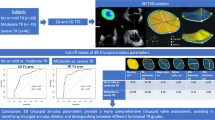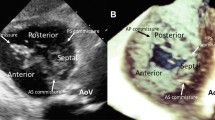Abstract
Tricuspid annular (TA) size, assessed by 2D transthoracic echocardiography (TTE), has a well-established prognostic value in patients undergoing mitral valve surgery, with TA dilatation triggering simultaneous tricuspid annuloplasty. While TA dilatation is common in patients with dilated atria secondary to atrial fibrillation, little is known about the mechanisms of TA dilatation in patients with sinus rhythm (SR). This study aimed to identify echocardiographic parameters most closely related to the TA size as a potential tool for identification of patients prone to developing TA enlargement. 120 patients with SR underwent clinically indicated TTE, including 30 patients with normal hearts and 90 patients diagnosed with at least one right heart abnormality, defined as: right ventricular (RV) or right atrial (RA) dilatation, ≥ moderate tricuspid regurgitation (TR) and elevated systolic pulmonary artery pressure (sPAP). RA and RV end-diastolic and end-systolic volumes (EDV, ESV) and function were measured using commercial 3D software (TomTec). 3D RV long and short axes were used as surrogate indices of RV shape. Degrees of TR and sPAP were estimated by 2D TTE. 3D TA sizing was performed at end-diastole using 3D custom software. Linear regression analysis was used to identify variables best correlated with TA size, followed by multivariate analysis to identify independent associations. The highest correlations were found between TA area and: RA ESV (r = 0.73; p < 0.01), RV EDV (r = 0.58; p < 0.01), RV end-diastolic long and short axes (r = 0.53, 0.42; both p < 0.01), TR degree (r = 0.40; p < 0.01) and sPAP (r = 0.32; p < 0.01). Multivariate analysis revealed that RA ESV was the only parameter independently associated with TA area (p < 0.05, r = 0.85). In conclusion, RA volume plays an important role in TA dilatation even in patients with normal SR. Understanding of annular remodeling mechanisms could aid in identifying patients at higher risk for TA dilatation, especially those scheduled for mitral valve surgery.




Similar content being viewed by others
Abbreviations
- EF:
-
Ejection fraction
- FAC:
-
Fractional area change
- MR:
-
Mitral regurgitation
- MV:
-
Mitral valve
- PISA:
-
Proximal isovelocity surface area
- SR:
-
Sinus rhythm
- sPAP:
-
Systolic pulmonary artery pressure
- 3D:
-
Three-dimensional
- TA:
-
Tricuspid annular
- TAPSE:
-
Tricuspid annular plane systolic excursion
- TR:
-
Tricuspid regurgitation
- TV:
-
Tricuspid valve
- 2D:
-
Two-dimensional
- RV:
-
Right ventricular
- VC:
-
Vena contracta
References
Baumgartner H, Falk V, Bax JJ et al (2017) 2017 ESC/EACTS guidelines for the management of valvular heart disease. Eur Heart J 38:2739–2791
Nishimura RA, Otto CM, Bonow RO et al (2017) 2017 AHA/ACC focused update of the 2014 AHA/ACC guideline for the management of patients with valvular heart disease: a report of the American College of Cardiology/American Heart Association Task Force on Clinical Practice Guidelines. J Am Coll Cardiol 70:252–289
Asmarats L, Puri R, Latib A et al (2018) Transcatheter tricuspid valve interventions: landscape, challenges, and future directions. J Am Coll Cardiol 71:2935–2956
Hausleiter J, Braun D, Orban M et al (2018) Patient selection, echocardiographic screening and treatment strategies for interventional tricuspid repair using the edge-to-edge repair technique. EuroIntervention 14:645–653
Utsunomiya H, Itabashi Y, Mihara H et al (2017) Functional tricuspid regurgitation caused by chronic atrial Fibrillation: a real-time 3-dimensional transesophageal echocardiography study. Circ Cardiovasc Imaging 10:e004897
Nath J, Foster E, Heidenreich PA (2004) Impact of tricuspid regurgitation on long-term survival. J Am Coll Cardiol 43:405–409
Koelling TM, Aaronson KD, Cody RJ et al (2002) Prognostic significance of mitral regurgitation and tricuspid regurgitation in patients with left ventricular systolic dysfunction. Am Heart J 144:524–529
Topilsky Y, Nkomo VT, Vatury O et al (2014) Clinical outcome of isolated tricuspid regurgitation. JACC Cardiovasc Imaging 7:1185–1194
Benedetto U, Melina G, Angeloni E et al (2012) Prophylactic tricuspid annuloplasty in patients with dilated tricuspid annulus undergoing mitral valve surgery. J Thorac Cardiovasc Surg 143:632–638
Dreyfus GD, Corbi PJ, Chan KM et al (2005) Secondary tricuspid regurgitation or dilatation: which should be the criteria for surgical repair? Ann Thorac Surg 79:127–132
Van de Veire NR, Braun J, Delgado V et al (2011) Tricuspid annuloplasty prevents right ventricular dilatation and progression of tricuspid regurgitation in patients with tricuspid annular dilatation undergoing mitral valve repair. J Thorac Cardiovasc Surg 141:1431–1439
Shiran A, Sagie A (2009) Tricuspid regurgitation in mitral valve disease incidence, prognostic implications, mechanism, and management. J Am Coll Cardiol 53:401–408
Chikwe J, Itagaki S, Anyanwu A et al (2015) Impact of concomitant tricuspid annuloplasty on tricuspid regurgitation, right ventricular function, and pulmonary artery hypertension after repair of mitral valve prolapse. J Am Coll Cardiol 65:1931–1938
Pettinari M, De Kerchove L, Lazam S et al (2018) Mid-term results of a randomized trial of tricuspid annuloplasty for less-than-severe functional tricuspid regurgitation at the time of mitral valve surgery†. Eur J Cardiothorac Surg 55(5):851–858
Seeburger J, Borger MA, Falk V et al (2008) Minimal invasive mitral valve repair for mitral regurgitation: results of 1339 consecutive patients. Eur J Cardiothorac Surg 34:760–765
Fukuda S, Saracino G, Matsumura Y et al (2006) Three-dimensional geometry of the tricuspid annulus in healthy subjects and in patients with functional tricuspid regurgitation: a real-time, 3-dimensional echocardiographic study. Circulation 114:I492–I498
Duran CM, Pomar JL, Colman T et al (1980) Is tricuspid valve repair necessary? J Thorac Cardiovasc Surg 80:849–860
Kara I, Koksal C, Erkin A et al (2015) Outcomes of mild to moderate functional tricuspid regurgitation in patients undergoing mitral valve operations: a meta-analysis of 2488 patients. Ann Thorac Surg 100:2398–2407
Miglioranza MH, Mihăilă S, Muraru D et al (2015) Variability of tricuspid annulus diameter measurement in healthy volunteers. JACC Cardiovasc Imaging 8:864–866
Miglioranza MH, Mihăilă S, Muraru D et al (2015) Dynamic changes in tricuspid annular diameter measurement in relation to the echocardiographic view and timing during the cardiac cycle. J Am Soc Echocardiogr 28:226–235
Volpato V, Lang RM, Yamat M et al (2019) Echocardiographic assessment of the tricuspid annulus: the effects of the third dimension and measurement methodology. J Am Soc Echocardiogr 32(2):238–247
Lang RM, Badano LP, Mor-Avi V et al (2015) Recommendations for cardiac chamber quantification by echocardiography in adults: an update from the American Society of Echocardiography and the European Association of Cardiovascular Imaging. J Am Soc Echocardiogr 28(1–39):e14
Tamborini G, Fusini L, Muratori M et al (2016) Right heart chamber geometry and tricuspid annulus morphology in patients undergoing mitral valve repair with and without tricuspid valve annuloplasty. Int J Cardiovasc Imaging 32:885–894
Addetia K, Muraru D, Veronesi F, et al. (2019) 3-Dimensional echocardiographic analysis of the tricuspid annulus provides new insights into tricuspid valve geometry and dynamics. J Am Coll Cardiol Cardiovasc Img 12:401–412. https://doi.org/10.1016/j.jcmg.2017.08.022
Nemoto N, Schwartz JG, Lesser JR et al (2017) The right atrium and tricuspid annulus are cardinal structures in tricuspid regurgitation with or without pulmonary hypertension. Int J Cardiol 230:171–174
Nemoto N, Lesser JR, Pedersen WR et al (2015) Pathogenic structural heart changes in early tricuspid regurgitation. J Thorac Cardiovasc Surg 150:323–330
Buzzatti N, De Bonis M, Moat N (2018) Anatomy of the tricuspid valve, pathophysiology of functional tricuspid regurgitation, and implications for percutaneous therapies. Interv Cardiol Clin 7:1–11
Medvedofsky D, Aronson D, Gomberg-Maitland M et al (2017) Tricuspid regurgitation progression and regression in pulmonary arterial hypertension: implications for right ventricular and tricuspid valve apparatus geometry and patients outcome. Eur Heart J Cardiovasc Imaging 18:86–94
Izumi C, Miyake M, Takahashi S et al (2011) Progression of isolated tricuspid regurgitation late after left-sided valve surgery. Clinical features and mechanisms. Circ J 75:2902–2907
Navia JL, Nowicki ER, Blackstone EH et al (2010) Surgical management of secondary tricuspid valve regurgitation: annulus, commissure, or leaflet procedure? J Thorac Cardiovasc Surg 139(1473–82):e5
McCarthy PM, Bhudia SK, Rajeswaran J et al (2004) Tricuspid valve repair: durability and risk factors for failure. J Thorac Cardiovasc Surg 127:674–685
Author information
Authors and Affiliations
Corresponding author
Ethics declarations
Conflict of interest
The authors declare that they have no competing interest.
Ethical approval
All procedures performed in studies involving human participants were in accordance with the ethical standards of the institutional and/or national research committee and with the 1964 Helsinki declaration and its later amendments or comparable ethical standards.
Informed consent
The study was approved by the Institutional Review Board with a waiver of consent.
Additional information
Publisher's Note
Springer Nature remains neutral with regard to jurisdictional claims in published maps and institutional affiliations.
Rights and permissions
About this article
Cite this article
Volpato, V., Mor-Avi, V., Veronesi, F. et al. Three-dimensional echocardiography investigation of the mechanisms of tricuspid annular dilatation. Int J Cardiovasc Imaging 36, 33–43 (2020). https://doi.org/10.1007/s10554-019-01686-7
Received:
Accepted:
Published:
Issue Date:
DOI: https://doi.org/10.1007/s10554-019-01686-7




